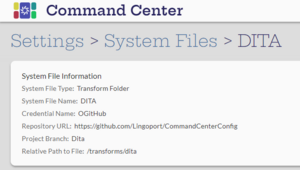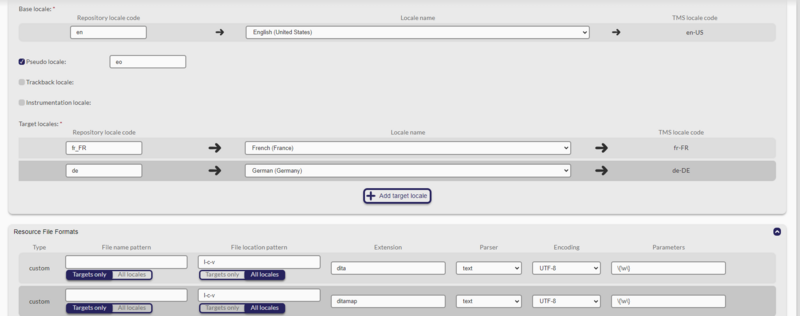Difference between revisions of "DITA Project Configuration"
(→Resource File Configuration) |
|||
| (2 intermediate revisions by the same user not shown) | |||
| Line 7: | Line 7: | ||
* See: https://www.oxygenxml.com/dita/1.3/specs/archSpec/base/introduction-to-dita.html |
* See: https://www.oxygenxml.com/dita/1.3/specs/archSpec/base/introduction-to-dita.html |
||
| − | DITA uses certain file extensions for topics, maps, and conditional processing profiles. Files that contain DITA content |
+ | DITA uses certain file extensions for topics, maps, and conditional processing profiles. Files that contain DITA content must use the following file extensions: |
| − | * DITA topics |
+ | * DITA topics: .dita |
| + | * DITA maps: .ditamap |
||
| − | ** .dita (preferred) |
||
| − | |||
| − | * DITA maps |
||
| − | **.ditamap |
||
For the purpose of Localyzer on-boarding, the source locale and target locales make up sibling directories under one DITA root. The file structure and files under each locale directory are the same, with .dita and/or .ditamap translated under each target directory. |
For the purpose of Localyzer on-boarding, the source locale and target locales make up sibling directories under one DITA root. The file structure and files under each locale directory are the same, with .dita and/or .ditamap translated under each target directory. |
||
| Line 21: | Line 18: | ||
An illustrative simple example is used to guide the on-boarding. Actual DITA repositories will follow most of the same on-boarding. |
An illustrative simple example is used to guide the on-boarding. Actual DITA repositories will follow most of the same on-boarding. |
||
| − | + | * In the repository, the directory under which the locale directories are located is <code>dita/Spectrum</code> |
|
| − | + | * Under <code>dita/Spectrum</code>, the source locale is <code>en</code> for United States English |
|
| − | + | * Under <code>dita/Spectrum/en</code> is the full directory structure for the DITA files. Path to actual .dita and .ditamap can be deep. |
|
| − | + | * Translation will be located under <code>dita/Spectrum/fr-FR</code> for France French |
|
| − | + | * Pseudo-localization will be located under <code>dita/Spectrum/eo</code> for Esperanto |
|
= Create a DITA Transform System File = |
= Create a DITA Transform System File = |
||
| Line 42: | Line 39: | ||
= Resource File Configuration = |
= Resource File Configuration = |
||
| − | Configure the project with the source locale |
+ | Configure the project with the source locale and target locales and use customer resource file format for the .dita and .ditmap: |
[[File:DITA Resource File Format.png | 800px]] |
[[File:DITA Resource File Format.png | 800px]] |
||
| Line 51: | Line 48: | ||
Run the project. |
Run the project. |
||
| − | Now add the transform configured above |
+ | Now add the transform configured above and add the pseudo-locale is necessary. |
Run the project again and verify the configuration. |
Run the project again and verify the configuration. |
||
Latest revision as of 16:09, 28 December 2023
Contents
DITA Introduction
The Darwin Information Typing Architecture (DITA) is an XML-based architecture for authoring, producing, and delivering topic-oriented, information-typed content that can be reused and single-sourced in a variety of ways. DITA is a standard that is applicable to any kind of publication or information that might be presented to readers, including interactive training and educational materials, standards, reports, business documents, trade books, travel and nature guides, and more.
Because DITA topics are conforming XML documents, they can be readily viewed, edited, and validated using standard XML tools, although realizing the full potential of DITA requires using DITA-aware tools.
DITA uses certain file extensions for topics, maps, and conditional processing profiles. Files that contain DITA content must use the following file extensions:
- DITA topics: .dita
- DITA maps: .ditamap
For the purpose of Localyzer on-boarding, the source locale and target locales make up sibling directories under one DITA root. The file structure and files under each locale directory are the same, with .dita and/or .ditamap translated under each target directory.
Illustrative DITA Sample, "Spectrum"
An illustrative simple example is used to guide the on-boarding. Actual DITA repositories will follow most of the same on-boarding.
- In the repository, the directory under which the locale directories are located is
dita/Spectrum - Under
dita/Spectrum, the source locale isenfor United States English - Under
dita/Spectrum/enis the full directory structure for the DITA files. Path to actual .dita and .ditamap can be deep. - Translation will be located under
dita/Spectrum/fr-FRfor France French - Pseudo-localization will be located under
dita/Spectrum/eofor Esperanto
Create a DITA Transform System File
Copy the transform from https://github.com/Lingoport/CommandCenterConfig branch main into your own repository and change the configuration file, 'dita_properties.sh' to point to the directory to start from, here dita/Spectrum
- DITA_DIR="dita/Spectrum"
As Administrator, go to Settings, and add a Transform directory, using the following:
- <your repository with the configured
dita_properties.sh - <your branch>
It should look close to the following:
Resource File Configuration
Configure the project with the source locale and target locales and use customer resource file format for the .dita and .ditmap:
Note:
Make sure to use the file location pattern with the right '-' (dash) or '_' (underscore) depending on the directory naming convention. Here, the targets are 'de' and 'fr-FR', hence the '-' in the l-c-v file name pattern, for both All locales
Run the project.
Now add the transform configured above and add the pseudo-locale is necessary.
Run the project again and verify the configuration.
The rest of the DITA configuration is the same as for any other projects.

